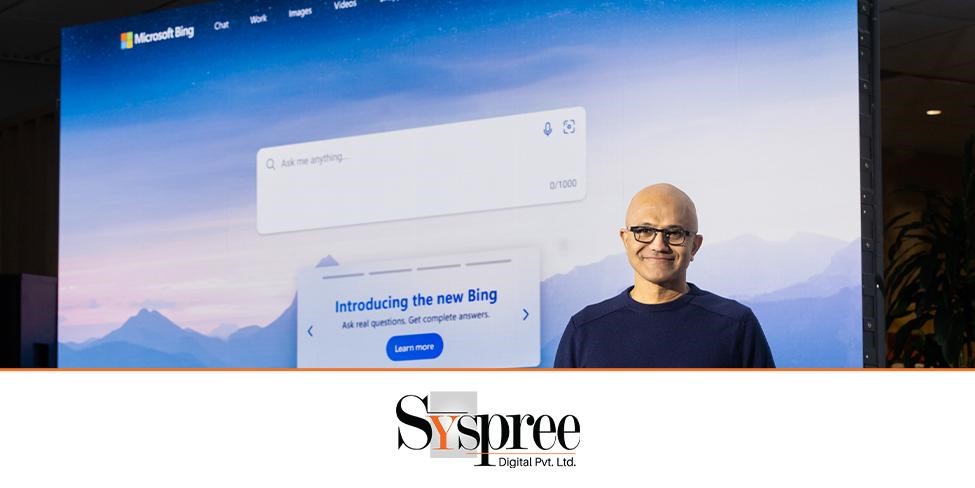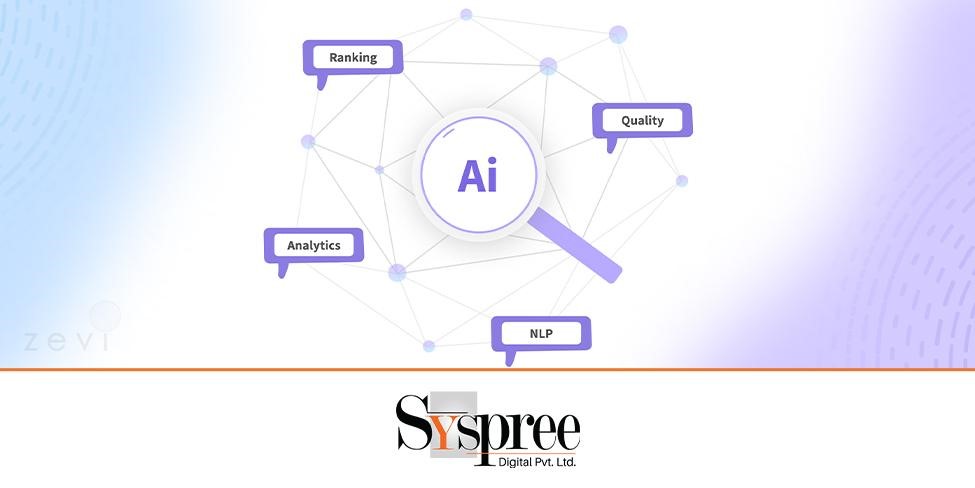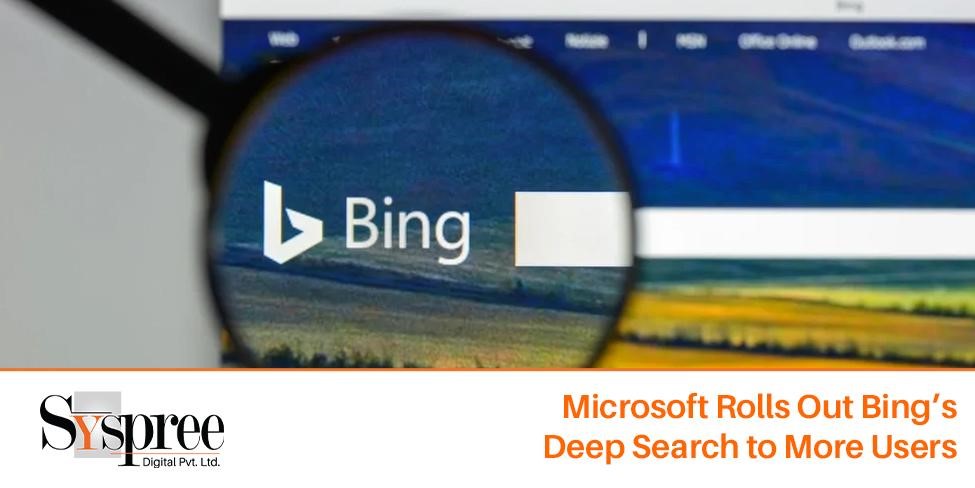Microsoft unveiled a revolutionary development in search technology last December with the preview of “Deep Search.” This optional feature of generative AI is designed to deal with complex queries without straightforward answers. It provides users with a refined and nuanced search experience. Using advanced artificial intelligence, Bing’s Deep Search is a powerful tool that can decipher complex questions. This improves the quality of results.
Overview of Microsoft’s Deep Search
Deep Search appears to expand its reach and is now available to a larger user base. This expansion is characterized by the prominent display at the top-right of the Bing Search box of the “Deep Search.” Users can spot the icon when they search. This indicates that the feature is available for their query. This visual cue gives users a glimpse of the potential for Deep Search and encourages them to take a more sophisticated approach to retrieving information.
After clicking on the “Deep Search,” users are taken to a screen where they can refine their Search. The message “Take a Second Look at Your Search” prompts the user to do so. This initiates several related searches powered using GPT-4‘s capabilities, a language model of the highest level. A search for SEO companies, for example, may produce results that demonstrate the AI’s ability to understand user queries’ varied intents and variations.
Although Deep Search is an important advancement in search technology, its deployment status remains ambiguous. Microsoft’s Mikhail Parakhin claims the feature has not yet been fully implemented. This raises questions about its usability. The leading SEO company in Mumbai says the first-hand reports confirm the presence of the “Deep Search icon” among users. This indicates a deployment in progress that promises to reshape how we interact with our search engines. Bing’s Deep Search will have a greater impact as more users interact with the feature. This is due to its innovative integration with GPT-4 and advanced algorithms.
Deep Search Rollout

Bing’s Deep Search – Deep Search Rollout
Microsoft’s Deep Search is revolutionizing search experiences and expanding its user base. The gradual rollout of this AI-generated feature, first shown as a preview in December 2023, suggests that more users will have access to it. Bing’s Deep Search impact is not only in its innovative features but also in its accessibility. It now reaches a wider audience.
Expansion to More Users
The “Deep Search Icon” at the top-right corner of the Bing box is a notable feature of this expansion. This visual cue is a gateway for a refined and nuanced experience in Search, encouraging users to explore deeper levels of information retrieval. This icon is visible after Bing searches, a sign of the rollout. The icon is a beacon that signals to those who are looking for a more advanced solution that Deep Search can now be reached.
Personal Observation of the “Deep Search” Icon
The experts from the leading SEO company in Mumbai say the users are taken to a special space when clicking the “Deep Search” icon. Here, they can refine their queries. The interface will prompt users to “Take a second look at your search” before a deeper analysis of the user’s query. GPT-4 is used to determine the intent and nuances of the Search. This leads to a customized and comprehensive set of results.
The status of Bing Deep Search is still ambiguous as the rollout continues. Microsoft’s Mikhail Parakhin hinted that this feature might not be live yet. This suggests a deployment in progress. Users’ observations of the “Deep Search icon” confirm that the feature is becoming more accessible.
User Experience
Bing’s Deep Search brings the user a whole new level of information retrieval. This is marked by the “Deep Search Icon” prominently displayed in the upper right corner of Bing’s search box. This icon is a gateway for a more refined and sophisticated search experience. Its unique design catches the attention of users and indicates its availability.
Description of “Deep Search” Icon
Deep Search is used to explore the many aspects of the initial Search. This comprehensive approach allows users to receive a tailored and relevant result. Deep Search, for example, will explore different intents and variations when a user searches on the topic of SEO companies triggers Deep Search to explore diverse intents and variations, ultimately presenting a refined list of results.
Refining Searches and the Process It Follows
The best SEO company says Deep Search is used to explore the many aspects of the initial search. This comprehensive approach allows users to receive a tailored and relevant result. Deep Search, for example, will explore different intents and variations when a user searches on the topic of SEO companies triggers Deep Search to explore diverse intents and variations, ultimately presenting a refined list of results.
Screenshots for Visual Understanding
Screenshots of the Deep Search user interface show the steps in detail to help users better understand the process. The visuals help users understand what to expect from the feature. This visual aid is not only a guide to the backend operations that Deep Search has, but it also helps users make the most out of this innovative technology.
Live Status
Bing’s Deep Search is continuing its rollout, and determining its status as live has become an important topic. Microsoft’s Mikhail Parakhin provided insight into the current deployment state, suggesting that the feature may not be fully active. Microsoft’s Parakhin has hinted at a continuous refinement, deployment, and testing process.
Insights from Microsoft’s Mikhail Parakhin

Bing’s Deep Search – Insights from Microsoft’s Mikhail Parakhin
User experiences, however, paint a very different picture. They indicate that Bing Deep Search is a feature of the search engine. The “Deep Search icon” is visible in the upper right corner of Bing’s search box. This indicates that it is accessible to a larger audience. Users across the spectrum use this innovative feature, indicating that its visibility extends beyond a limited preview.
This coexistence, where Microsoft’s representative suggests a gradual rollout and users confirm the visibility of “Deep Search,” adds an interesting layer to the story. This raises questions regarding the complexity of the deployment strategy and how far Deep Search has penetrated the user base.
Underlying Technology
Bing’s Deep Search is a testimony to the fusion of cutting-edge technologies and complex architecture that reimagines the world in search technologies. Its core is that Deep Search is built upon Bing’s dependable web index as well as its ranking and indexing system, using Bing’s massive online repository of information. The experts from the best SEO company say this integration enables Deep Search to draw from the vast database of information, providing a complete study of user queries.
One of the most significant advancements that have boosted DeepSearch’s capabilities is its seamless integration of GPT-4, a robust and sophisticated language model created by OpenAI. GPT-4 is a key component in deciphering the complexities of user queries and identifying the different meanings and subtleties that can be hidden within complex requests for information. This integration enables Deep Search to go beyond the superficiality of search queries by revealing the nuances and divergent interpretations that could be embedded in users’ language.
Overview of Deep Search Architecture
The search architecture of Deep Search is designed to improve the search experience using GPT-4 to compute descriptions of each of the possible intentions and variations that a query might have. The process creates an “ideal set of results” designed to satisfy the particular needs of the user’s Search. Combining the indexing capabilities of Bing with the language comprehension capabilities of GPT-4 Deep Search aims to offer the most precise, refined, and user-centric results.
Integration with Bing’s Web Index and GPT-4
The leading digital marketing agency in Mumbai says the intricate interplay between Bing’s web index and ranking system and the awe-inspiring capabilities of GPT-4 places Deep Search at the forefront of AI-driven technology for Search. This technology integration is not just a major technological advancement for Microsoft’s search services but also illustrates the synergies that can be achieved with the combination of cutting-edge algorithms and massive data sets.
In the meantime, as Bing’s Deep Search continues to unfold, it signals an era of change in which the combination of advanced design as well as advanced models of language takes the user experience on search engines to new frontiers of accuracy and precision.
Results and Rankings
Bing’s Deep Search’s success lies in its technological advancements and the complex algorithms that govern its results and ranking system. Deep Search employs a multifaceted approach that considers a range of variables to ensure quality and relevant search outcomes.
Factors Influencing Deep Search Results Ranking

Bing’s Deep Search – Results and Rankings
One of the main factors in determining Deep Search results ranking is aligning a web page with Bing’s extended description. The system assesses whether the page is aligned with the overall description derived from the user’s query. This attention to alignment means that the results are closely aligned with the user’s intent, creating an accurate and meaningful user experience.
Emphasis on Relevance, Quality, Credibility, Freshness, and Popularity
Relevance is a key factor in the Deep Search ranking algorithm. The algorithm evaluates whether a website’s content corresponds to the user’s query and evaluates its relevance in context. The algorithm also considers the quality of information and favors pages that offer sufficient and appropriate amounts of information to the user’s request.
Credibility and trustworthiness are crucial factors influencing the rankings for Deep Search results. The system assesses the source of information and prioritizes content from reliable and trusted sources. This assures that users are provided with reliable information and improves the overall quality of the search results.
Freshness is a crucial factor that affects Deep Search results. The system takes into consideration and prioritizes the most recent and current information. This method of updating ensures that users get the most current and relevant information crucial for fast-changing subjects.
Popularity, as measured by general appeal and the level of engagement with a website, is a factor in Deep Search ranking. This indicates the preferences of a larger number of users and aligns with the belief that widely acclaimed and well-known content usually has intrinsic value.
AI in Search Landscape

Bing’s Deep Search – AI in Search Landscape
Integrating AI features is crucial in the ever-changing landscape of search engines. It enhances user experience. Bing Deep Search is unique compared to AI-driven features such as Bing Chat and Google Bard.
Comparison with Other AI-Driven Search Features
The experts from the leading digital marketing agency in Mumbai say Bing Chat brings unique AI capabilities to the search field. Bing Chat is a conversational search interface that allows users to dialog with the search engine. Google Bard focuses on voice search, multimedia interactions, and a visually immersive environment. Google SGE (Search, Guide, and Explore) combines a conversational user interface with contextual data to create a more intuitive search process.
Potential Advantages of Deep Search in Driving Clicks
Deep Search can be a powerful tool for driving traffic by presenting highly personalized and relevant results. Deep Search overcomes the limitations of traditional search algorithms by leveraging GPT-4, which can discern complex intents or variations. Users will likely click on results that precisely match their query depth and complexity, resulting in a more satisfying experience. The slower loading speed may be a problem, but the more meaningful results could make Deep Search a game changer, boosting user engagement.
Future Implications
With its innovative combination of GPT-4 with sophisticated search algorithms, Bing’s Deep Search can change how people interact with search engines in the coming years. One of the major impacts on the future lies in its potential impact on how people search.
The ability of Deep Search to distinguish complicated queries and deliver more precise result sets suggests that people could slowly develop a preference for customized and more individualized experiences when searching. When users get used to the richness and depth offered by Deep Search, it could alter their expectations and lead to a desire for more precise and personalized results in the wider market of search engines.
Speculation on the Impact of Deep Search on Search Behavior
A key factor when it comes to the use of Deep Search is the challenge that is posed by the user’s patience. The feature is revolutionary in its concept but is also characterized by slow loading times compared to normal search results. With a delay of 30 seconds, Deep Search requires a degree of patience that could be unbalanced by the rapid pace of internet-based search results. In a time when users are used to instant results, the long loading time could pose an obstacle to widespread acceptance.
Consideration of User Patience as a Potential Challenge
The balance between the transformative capabilities of Deep Search and the user’s willingness to wait for a delay in gratification is an important factor in determining the long-term viability of Deep Search. Microsoft recognizes the slow loading speed and its potential impact on user experience but leaves the possibility of enhancement and optimization in the coming updates.
Conclusion
Bing’s Deep Search, which was previewed last December, is a revolution in search by integrating GPT-4. When it expands its reach, the obvious “Deep search” icon suggests an improved search experience despite potential user patience challenges. If you like this blog check out our previous blog 5th Week Roundup: Google’s Indexing Issues, Google Introduces ‘Circle to Search’, Google Retires Cache Links and Much More!







